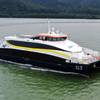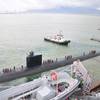Civilian and military employees of the U.S. Navy's Military Sealift Command, headquartered in Washington, D.C., took part in the second annual "Run for America" from September 8-11, 2002.
They joined hundreds of other employees from throughout the Department of Defense on a 467-mile relay from the Pentagon in Washington, D.C., to ground zero in New York City to commemorate the lives lost in the September 11, 2001 terrorist attacks.
The relay also route passed through the location of the Flight 93 memorial in Shanksville, Penn.
The entire event took more than 79 hours to complete, with each group of runners covering an average of five miles, and culminated in the presentation of an American flag to New York City Mayor Michael Bloomberg. The flag had been flown by U.S. forces during Operation Enduring Freedom and was passed between the groups of runners along the route.
Many military and civilian MSC employees took part in the run. Military personnel who participated included Lt. Cmdr. Richard Woodford, Lt. Cmdr. Greg Tiemann, USN, Lt. Cmdr. Richard Tschiegg, USNR, Lt. Christopher Anderson, USN, Command Master Chief Michael Oldknow, USN, Master Chief Kevin Blade, USN and Master Chief Clyde Armstrong, USN. Civilian employees who ran were Mark Andress, Joan Divens, Harry Elliott IV, Gary Brinson, Carlos Coronado, Art Padama, Ken Rascher and Matthew Kane.
MSC legislative analyst Harry Elliott IV was deeply touched by the outpouring of support for himself and the other runners. "Having the real heroes -- the police officers and the firefighters – cheer us on as we approached the former site of the Twin Towers was very moving. When we reached ground zero, we had all of the crowd that had gathered there on one side of us and the police and fire personnel on the other, cheering and waving American flags," said Elliott. "It was something I'll never forget."
Military Sealift Command, the ocean transportation
provider for the Department of Defense, operates about 115 noncombatant Navy ships. MSC ship missions vary from the transport and afloat prepositioning of defense cargo; to underway replenishment and other direct support to Navy ships at sea; to at-sea data collection for the U.S. military and other U.S. government agencies.
Featured videos

Inside the Electrified Truckable Tug

Inmarsat Enhances Service to Drive Digitalization

Tracking Foreign Vessels Working in the U.S. Jones Act Market
Subscribe for
Maritime Reporter E-News
Maritime Reporter E-News is the maritime industry's largest circulation and most authoritative ENews Service, delivered to your Email five times per week









